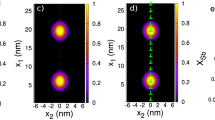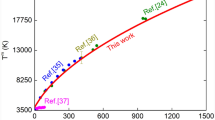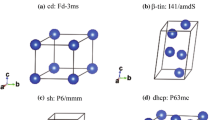The kinetics of structural relaxation in oxide systems containing complexing elements—boron and silicon— was studied by the potentiometric method. The effect of the nature and composition of the oxide electrolyte and the quenching temperature on the kinetic parameters of the anionic polymerization process was uncovered. Modeling of the relaxation processes in liquid borosilicates was conducted. Two kinetic schemes of structural relaxation, taking account of the slowness of the depolymerization of silicon oxide complexes and change of the coordination of boron, are examined. The influence of different physical and chemical factors on the rate of the relaxation processes and the equilibration time are analyzed.






Similar content being viewed by others
References
M. N. Schulz and O. V. Mazurin, Modern Ideas About the Structure of Glasses and Their Properties [in Russian], Nauka, Leningrad (1988).
N. A. Vatolin and E. A. Pastukhov, Diffraction Studies of the Structure of High-Temperature Melts [in Russian], Nauka, Moscow (1980).
B. M. Lepinskikh, O. A. Esin, and V. I. Musikhin, “Anisotropy of electrical conductivity of molten silicates and borates during flow,” The Glassy State, Akad. Nauk SSSR, Moscow – Leningrad (1960), pp. 125 – 127.
I. V. Timoshenko and A. F. Borisov, “Application of the EMF method to study the structure of glass with industrial composition,” in: The Glassy State [in Russian], Akad. Nauk SSSR, Moscow (1970), pp. 242 – 246.
V. N. Anfilogov and V. N. Bykov, Silicate Melts. Structure, Thermodynamics, Physical Properties [in Russian], Imin UrO RAN, Miass (1998).
S. V. Nemilov, “Viscosity of borate glass-forming melts: features of the tetrahedron BO4 as a kinetic unit,” Fiz. Khim. Stekla, 23(1), 3 – 42 (1997).
V. I. Malkin, “On the dependence of the relative mobility of cations on the ratio of their coordination numbers in three-component silicate melts,” Zh. Fiz. Khim., 35, 336 – 341 (1961).
A. A. Appen, “On the state and properties of boric anhydride in silicate glasses,” Zh. Fiz. Khim., 26(6), 569 – 578 (1953).
O. V. Mazurin, The Glass Transition [in Russian], Leningrad (1986).
O. I. Ostrovskii, V. A. Grigoryan, and A. F. Vishkarev, Properties of Metal Melts [in Russian], Metallurgiya, Moscow (1988).
V. K. Novikov, “Development of a polymer model of silicate melts,” Rasplavy, 1(6), 21 – 33 (1987).
K. Moynihan, P. Masedo, N. Saad, et al., “Kinetics of the glass transition,” Fiz. Khim. Stekla, 1(5), 420 – 426 (1975).
Author information
Authors and Affiliations
Corresponding author
Additional information
Translated from Steklo i Keramika, No. 12, pp. 3 – 9, December, 2018.
Rights and permissions
About this article
Cite this article
Vatolina, N.D., Dobrynina, N.Y. & Vatolin, A.N. Kinetics of the Structural Relaxation in Borosilicate Melts. Glass Ceram 75, 459–464 (2019). https://doi.org/10.1007/s10717-019-00112-7
Published:
Issue Date:
DOI: https://doi.org/10.1007/s10717-019-00112-7




